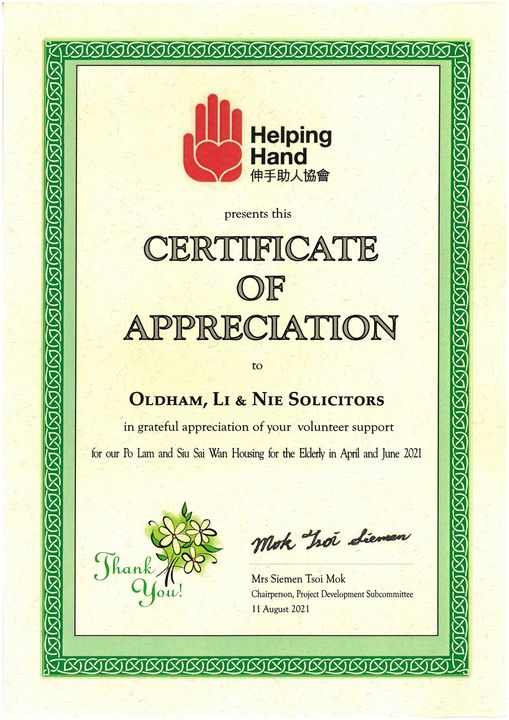The pandemic has turned our lives upside down. Not only because of the health consequences of the Coronavirus, but also because if you and your family are used to traveling, this last year and a half has been challenging.
Whether you are a Hongkonger owning a holiday home in Europe, or a European living and working in Hong Kong, this crisis has shown us that international travel as we know might become more complicated.
These uncertain times are the opportunity to reflect about our future, particularly when it comes to families owning assets in several countries, parents whose children live abroad, or expats who are considering returning to their home countries.
Estate planning is a real issue that should not be left for last minute. It is indeed possible to plan ahead to avoid difficulties arising upon death. There are several tools which will give you and your family a bit of certainty about the future.
OLN can help you secure your assets and plan your inheritance in advance.
The complexity of international estate planning
European inheritance law might become complex when it comes to international families, especially regarding the following aspects:
- Forced heirship: most European countries apply a system of reserved heirs, a form of inheritance which mandates how the deceased’s estate is to be disposed of and which tends to guarantee an inheritance for the family of the deceased. Indeed, in Europe you are not allowed to disinherit your children.
- Inheritance tax: some European countries are entitled to tax the assets your heirs will receive after your demise. This could particularly apply to immovable assets located in France.
- Specific documents: European countries may ask for documents from a national lawyer or Notary for amending the Property Deed of your real estate after the demise of the owner.
The impact of the matrimonial property regime in inheritance law
Many foreign couples got married abroad or even in Hong Kong without drafting a prenuptial or postnuptial agreement.
Depending on the countries involved in your particular situation – nationality of the spouses and heirs, location of the assets – the applicable law to the matrimonial property regime could affect inheritance.
Foreigners living in Europe and Europeans living in Europe and abroad are able to choose the applicable law to their matrimonial property regime. Indeed, European Regulation No. 2016/1103 of 24 June 2016 implementing enhanced cooperation in the area of jurisdiction, applicable law and the recognition and enforcement of decisions in matters of matrimonial property regimes entered in force on 29th January 2019. Article 22 of this regulation allows couples to designate either the national law of one of the spouses, either the law of their habitual residence.
Once the applicable law designated, the spouses will be able to choose their matrimonial property regime. For example, a couple might choose separation of assets. However, under some European laws the spouses might be able to choose another property regime, more protective to the other spouse upon death.
This choice could have an impact on inheritance, since the surviving spouse might be entitled to a significant part of the assets acquired during marriage.
To determine your matrimonial property regime is therefore essential for estate planning.
Choosing the best applicable law to your inheritance
In order to limit the difficulties raised above, the European Union adopted Regulation No 650/2012 on jurisdiction, applicable law, recognition and enforcement of decisions and acceptance and enforcement of authentic instruments in matters of succession and on the creation of a European Certificate of Succession.
From a European point of view, the applicable law to the succession will be the law of the last domicile of the deceased. However, the regulation allows citizens to choose their national law as the applicable law. A competent lawyer in both jurisdictions will be able to advise you about the best applicable law for your inheritance.
The regulation also creates a “European Certificate of Succession”, an essential document to be drafted by a local authority in order to transfer the ownership of the assets located in Europe to the heirs.
The local authority will need to ensure that the will respects European procedures.
Tools to protect your assets and plan your inheritance
Several tools are available for international estate planning besides drafting a will in Europe and Hong Kong. You could consider donating part of your assets to your children or incorporating a company who will own your real estate for your family.
- European and Hong Kong wills: an analysis of your situation, the location of your assets and the tax residence of your family members is necessary to assess the suitability of a Hong Kong or European will. In some cases, a European will would be more appropriate. Depending on the case, a Hong Kong will would be needed to complete the European will. In any event, if you own any assets in Europe, it is advisable to take into consideration the tax implications for your heirs before drafting the will.
- Donation to children during lifetime: in some cases, giving part of our assets to your children during your lifetime would decrease your estate upon death and therefore the tax will be lower. For example, in France parents are allowed to give up to 100.000 € per parent and per child every fifteen years, exempt of tax.
- Donation of the real ownership of immovable assets to the children: in some European countries, it is possible to separate the real ownership from the usufruct. One way of decrease your estate before death and to keep the use of the house could be donating the real ownership to your children while the parents keep the usufruct until their death.
- Incorporation of a Property Company: some European countries like France provide many ways to limit the inheritance problems for real estate. One of the most popular ones would be creating a “Société Civile Immobilière”, a Property Company owning the real estate instead. Upon demise, the heirs will inherit the shares of the Company and not the real estate itself.
- Trusts: most Continental European laws do not permit to set up trusts. It is however possible to set up a trust in Hong Kong but legal advice is mandatory to ensure that there will be no consequences for the inheritance of European assets.
An assessment of your particular situation is needed in order to determine the best options international law can offer.
Brexit
I sadly need to remind you that the United Kingdom is not a part of the European Union since January 2021. But for every problem, a solution: our specialized lawyers at OLN can advise you on estate planning in the United Kingdom, Continental Europe and Hong Kong!
September 2021
 Suite 503, 5/F, St. George's Building, 2 Ice House Street, Central, Hong Kong
Suite 503, 5/F, St. George's Building, 2 Ice House Street, Central, Hong Kong +852 2868 0696
+852 2868 0696








